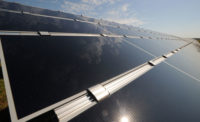Top 400 Sourcebook
Technology Cuts Costs For Solar, Wind Projects
Renewables expected to take lion’s share of generation

Contractors are embracing new technologies to help reduce costs for traditional and renewable electricity generation as the industry continues to build, almost exclusively, natural gas, solar and wind power plants.
Mortenson Construction is using innovative construction technologies to increase the speed of its work and drive down costs for wind energy, says Tom Wacker, chief operating officer for the company. Further, Black & Veatch says it is using a programmatic approach to achieve lower costs through economies of scale. The Kansas City-based engineer is using 3D projections and virtual reality to help constructors visualize plans.
In fact, technological advancements are driving down the costs of wind and solar power so much that construction of the two renewable technologies are expected to equal, if not surpass construction of natural-gas power plants over the next two decades, according to the Energy Information Administration. After 2030, new generation-capacity additions will be split primarily between solar and natural gas, with solar capacity representing more than 50% of new-capacity additions.
ENR 2017 Top 400 Contractors
ENR 2017 Top 400 Contractors Full PDF
“The evolution of gas, wind and solar technologies that improve efficiency is already happening and will be tough to overcome moving forward,” Wacker says.
Mortenson currently is building a 600- MW wind project in Colorado for Xcel Energy and has begun a 170-MW wind farm in Iowa for MidAmerican Energy, which plans to add 2,000 MW of wind in the state. The company also is building multiple utility-scale solar projects.
While the Obama administration’s Clean Power Plan requiring the electricity sector to cut carbon emissions has been stayed by the court while the Trump administration crafts a replacement policy expected to be much less restrictive, the movement away from coal and toward renewable power will continue.
“Demand and market forces will still primarily determine how much generation gets built going forward,” says Roger Lenertz, executive vice president of power at Black & Veatch. However, Lenertz notes that, without the Clean Power Plan, utilities may build more natural-gas generation than was expected under the Obama plan. Additionally, fewer coal plants may have to retire. Black & Veatch is providing engineering-procurement-construction services for Tenaska’s new 925-MW natural-gas combined-cycle power plant, near Pittsburgh.
The rollback of the Clean Power Plan likely will mean that the construction of new plants to replace older coal and natural gas-fired plants will slow down, Wacker adds. Since electricity demand is expected to remain relatively flat for a while, the main drivers for building a new generation of power plants are the retirement of older plants and state renewable portfolio standards, Wacker says.
Utilities increasingly are building distributed energy resources “to provide lower future costs, environmentally sustainable solutions and disruptive technology introduction,” Lenertz says.
Black & Veatch also sees more investments directed toward transmission and distribution assets to help bring more renewables to market.





